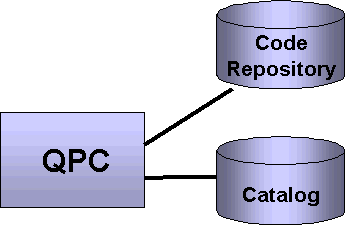| Overview |
| Components |
| Client API |
| QPC |
| DAP |
| Data Server |
| Plug-And-Play |
| Catalog |
| Benefits |
| Home |
Query Processing Coordinator (QPC)
The Query Processing Coordinator (QPC), shown in Figure 3, is the middle-tier component that controls the execution of all queries received from the client applications. In effect, the QPC is the integration server of the system, and therefore, it is implemented a multi-threaded Java server. The QPC can be reached by the clients through a well-known URL. QPC provides services such as query parsing, query validation, query optimization, plan decomposition, metadata management, query execution and coordination, and error management. The QPC has a catalog which holds all the metadata about the user-defined types, methods, and data sites available for use by the users. All metadata in this catalog are encoded using XML and RDF (Resource Description Framework), which provide MOCHA with a standardize and platform-independent solution for metadata exchange. In addition to the catalog, the QPC also has a code repository which stores the compiled Java classes that implement the various user-defined data types and operators (methods) that are available to the user.

Figure 3: Query Processing Coordinator
When QPC receives a query from a client, it carries out the following tasks:
- Query Parsing - QPC parses the SQL string representing the query and and generates a tree representing the tables, attributes and expression that form part of the query.
- Resource Discovery - QPC accesses the catalog in search for the metadata describing the tables, types, methods, and data sources that are needed to solve the query. At this stage the query is validated to make sure it is syntactically and semantically correct.
- Query Optimization - The query optimizer embedded in the QPC generates an efficient execution plan to solve the query. This optimizer is based on the System-R dynamic programming paradigm, enhanced with various heuristics to help it place the execution of user-defined methods at either the QPC or the DAPs associated with the data sources to be accessed. Such heuristics attempt to reduce the volume of data transmitted over the network during query execution, and are based on a new metric that we call the Volume Reduction Factor (VRF).
- Metadata and Control Exchange - The QPC decomposes the query plan produced by the optimizer into the components to be executed by each DAP and those to be executed by itself. Then QPC sends each participating DAP the metadata and the fragment of the plan each must execute. The metadata and query plan are send to the DAPs as XML documents, which makes metadata and control exchange in MOCHA platform-independent.
- Code Deployment Phase - From the metadata and query plan, the QPC infers which are the Java classes needed to handle the query, and where should these classes be deployed. Then, QPC fetches all required Java classes from the code repository, and ships them to the client and each DAP. We call this process, the code deployment phase, and is a fully automatic process carried out by the QPC without any human involvement. In effect, the QPC extends the capabilities of the client, each participating DAP and itself, in order to adapt to the requirements of the query being solved. For this reason we call MOCHA a self-extensible middleware system.
- Query Execution - Once the code deployment phase is completed, the QPC signals each DAP to start executing the query plan that each one received. Each DAP accesses the data in the data source and processes them according to the query plan. All these results are then send to QPC for further processing, and then QPC forwards the final values to the client application for visualization purposes.
PREVIOUS NEXT
© 2000 University of Maryland. All rights reserved.

